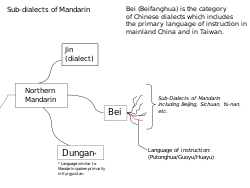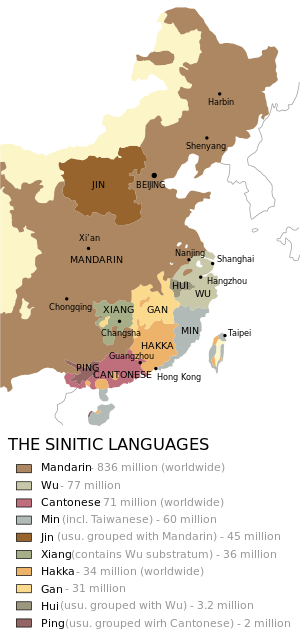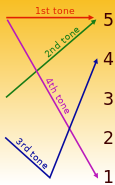الصينية الفصحى
| المندرينية الفصحى Standard Mandarin | ||
|---|---|---|
| 普通話 / 普通话 Pǔtōnghuà 國語 / 国语 Guóyǔ 華語 / 华语 Huáyǔ 現代標準漢語 / 现代标准汉语 Xiàndàibiāozhǔnhànyǔ | ||
| تـُستخدم في | جمهورية الصين الشعبية, تايوان, سنغافورة | |
| إجمالي المتكلمين | 885 million (first language speakers) [1] | |
| الترتيب | 1 (native speakers) | |
| عائلة لغات | صينو-تبتية
| |
| الوضع الرسمي | ||
| لغة رسمية في | Official language of جمهورية الصين الشعبية وتايوان وسنغافورة | |
| ينظمها | In the PRC: National Language Regulating Committee[1] In the ROC: National Languages Committee In Singapore: Promote Mandarin Council/Speak Mandarin Campaign[2] | |
| أكواد اللغة | ||
| ISO 639-1 | zh | |
| ISO 639-2 | chi (B) | zho (T) |
| ISO 639-3 | cmn | |
| ملاحظة: هذه الصفحة قد تتضمن رموز صوتية من IPA مكتوبة باليونيكود. انظر جدول IPA للإنجليزية لمفتاح نطق مبني على الإنجليزية. | ||
المندرينية هي اللغة الرسمية في جمهورية الصين الشعبية وتستخدم في تايوان و سنغافورة والجدير بالذكر ان المندرينية تحتوي على عدد كبير من اللهجات وتستخدم بكثرة في شمال وجنوب غرب الصين.
Standard Chinese, also known as Modern Standard Mandarin, Standard Mandarin, Modern Standard Mandarin Chinese (MSMC), or simply Mandarin, is a standard variety of Chinese that is one of the official languages of China. Its pronunciation is based on the Beijing dialect, its vocabulary on the Mandarin dialects, and its grammar is based on written vernacular Chinese. The similar Taiwanese Mandarin is a national language of Taiwan. Standard Singaporean Mandarin is one of the four official languages of Singapore.
Like other varieties of Chinese, Standard Chinese is a tonal language with topic-prominent organization and subject–verb–object word order. It has more initial consonants but fewer vowels, final consonants and tones than southern varieties. Standard Chinese is an analytic language, though with many compound words.
Standard Chinese is a standardised form of the language called Putonghua in Mainland China. Guoyu (Standard Taiwanese Mandarin) is a similar linguistic standard in Taiwan. Aside from a number of differences in pronunciation and vocabulary, Putonghua is written using simplified Chinese characters (plus Hanyu Pinyin romanization for teaching), and Guoyu is written using traditional Chinese characters (plus Zhuyin for teaching). Many characters are identical between the two systems.
. . . . . . . . . . . . . . . . . . . . . . . . . . . . . . . . . . . . . . . . . . . . . . . . . . . . . . . . . . . . . . . . . . . . . . . . . . . . . . . . . . . . . . . . . . . . . . . . . . . . . . . . . . . . . . . . . . . . . . . . . . . . . . . . . . . . . . . . . . . . . . . . . . . . . . . . . . . . . . . . . . . . . . . .
Names
In Chinese, the standard variety is known as:[3]
- 普通话 (普通話؛ Pǔtōnghuà؛ 'common speech'�) in the People's Republic of China, as well as Hong Kong and Macau;
- 國語 (国语؛ Guóyǔ؛ 'national language'�) in Taiwan, elsewhere in the Chinese diaspora and in some contexts in the People's Republic of China;
- 華語 (华语؛ Huáyǔ؛ 'Chinese language'�) in Singapore, Malaysia, Indonesia, the Philippines, and the rest of Southeast Asia and in some contexts in the People's Republic of China and Taiwan;[4] and
- 漢語 (汉语؛ Hànyǔ؛ 'language of the Han Chinese'�) in the United States and elsewhere in the Chinese diaspora and also commonly used in the People's Republic of China.
Standard Chinese is also commonly referred to by generic names for "Chinese", notably 中文؛ Zhōngwén؛ 'Middle [i.e. Chinese] writing'�, 官話؛ Guānhuà؛ 'Mandarin language'� and 中国话؛ 中國話؛ Zhōngguóhuà؛ 'Middle Kingdom [i.e. China] speech'� (compare 英文؛ Yīngwén؛ 'English writing'� for English, and 英国؛ Yīngguó؛ 'English country [i.e. England]'�). In total, there have been known over 20 various names for the language.[5]
مخارج البدء
The following is the initial inventory of Standard Mandarin as represented in the International Phonetic Alphabet (IPA):
| Bilabial | Labio- dental |
Alveolar | Retroflex | Alveolo- palatal |
Velar | |||||||
|---|---|---|---|---|---|---|---|---|---|---|---|---|
| Plosives | p | pʰ | t | tʰ | k | kʰ | ||||||
| Nasals | m | n | ||||||||||
| Fricatives | f | s | ʂ | (ʐ)1 | ɕ | x | ||||||
| Affricates | ʦ | ʦʰ | ʈʂ | ʈʂʰ | tɕ | tɕʰ | ||||||
| Lateral approximant |
l | |||||||||||
| Approximants | w | ɻ1 | j | ɥ | ||||||||
1 /ɻ/ is often transcribed as [ʐ] (a voiced retroflex fricative). This represents a variation in pronunciation among different speakers, rather than two different phonemes.
Corresponding chart in:
- Pinyin
- Zhuyin
- Gwoyeu Romatzyh
مخارج الانتهاء
There are at least the following phones:
- [a] (only in finals [a], [ia], [ua], [ya], [aɪ], [uaɪ], [uan])
- [ɑ] (only in finals [ɑʊ], [iɑʊ], [ɑŋ], [iɑŋ], [uɑŋ])
- [e] (only in finals [eɪ] and [ueɪ])
- [ɛ] (only in finals [iɛ], [iɛn], [yɛn] and in the isolated word [ɛ])
- [œ] (only in final [yœ])
- [o] (only in finals [ou] and [iou])
- [ɔ] (only in final [uɔ] and in the isolated word [ɔ])
- [ə] (only in finals [ən], [uən], [əŋ], [uəŋ])
- [ɤ] (only in final [ɤ])
- [z̩] (only in final [z̩], which occurs only after alveolar sibilants; sometimes pronounced as [ɨ])
- [ʐ̩] (only in final [ʐ̩̩], which occurs only after retroflex sibilants; sometimes pronounced as [ɨ])
- [i] (only in finals [i], [in], [iŋ])
- [ʊ] (only in finals [ʊŋ], [yʊŋ])
- [u] (only in final [u])
- [y] (only in final [y], [yn])
This shows fourteen different vowels. By very conservative standards, this represents a system of eight phonemes: /a/ ([a]/[ɑ]), /e/ ([e]/[ɛ]), /o/ ([o]/[ɔ]), /ə/ ([ə]/[ɤ]), /z̩/([z̩]/[ʐ̩]), /i/, /u/ ([ʊ]/[u]), and /y/.
When the medial, nucleus, and coda combine into a final, their pronunciations may be affected. The following is the full table of finals of Standard Mandarin in the IPA:
| Nucleus | Coda | Medial | |||
| Ø | i | u | y | ||
| a | Ø | a | ia | ua | |
| i | aɪ | uaɪ | |||
| u | ɑʊ | iɑʊ | |||
| n | an | iɛn | uan | yɛn | |
| ŋ | ɑŋ | iɑŋ | uɑŋ | ||
| ə | Ø | ɤ | iɛ | uo 1 | yɛ ² |
| i | ei | uei | |||
| u | ɤʊ | iɤʊ | |||
| n | ən | in | uən | yn | |
| ŋ | ɤŋ | iŋ | uɤŋ ³ | yʊŋ | |
| Ø | z̩ | i | u | y | |
1 Both pinyin and zhuyin have an additional "o", used after "b p m f", which is distinguished from "uo", used after everything else. "o" is generally put into the first column instead of the third. However, in Beijing pronunciation, these are identical.
² Another way to represent the four finals of this line is: [ɯʌ iɛ uɔ yœ], which reflects Beijing pronunciation.
³ /uɤŋ/ is pronounced [ʊŋ] when it follows an initial.
Corresponding chart in:
- Pinyin
- Zhuyin
- Gwoyeu Romatzyh
A table of valid initial and final combinations can also be seen at:
المخارج النغمية
| Tone name | Yin Ping | Yang Ping | Shang | Qu |
|---|---|---|---|---|
| Tone number | 1 | 2 | 3 | 4 |
| Pinyin diacritic | ā | á | ǎ | à |
| Tone contour | ˥ (55) | ˧˥ (35) | ˩, ˨˩˦ (1, 214) | ˥˩ (51) |
| IPA diacritic | á | ǎ | à, á̀́ | â |
. . . . . . . . . . . . . . . . . . . . . . . . . . . . . . . . . . . . . . . . . . . . . . . . . . . . . . . . . . . . . . . . . . . . . . . . . . . . . . . . . . . . . . . . . . . . . . . . . . . . . . . . . . . . . . . . . . . . . . . . . . . . . . . . . . . . . . . . . . . . . . . . . . . . . . . . . . . . . . . . . . . . . . . .
مقارنة كلمات
| العربية | الصينية (التقليدية) |
الصينية (البسيطة) |
المندرينية |
|---|---|---|---|
| مرحبا | 你好 | 你好 | Nǐhǎo |
| ما اسمك ؟ | 你叫什麼名字? | 你叫什么名字? | Nǐ jiào shénme míngzi? |
| اسمي هو... | 我叫... | 我叫... | Wǒ jiào... |
| كيف حالك ؟ | 你好嗎? | 你好吗?/ 你怎么样? | Nǐ hǎo ma? / Nǐ zěnmeyàng? |
| أنا بخير، وأنت ؟ | 我很好,你呢? | 我很好,你呢? | Wǒ hěn hǎo, nǐ ne? |
| I don't want it. | 不要。 | Bú yào. | |
| شكراً لك | 謝謝 | 谢谢 | Xièxiè |
| Welcome! / You're welcome! | 歡迎您!/ 不用謝! | 欢迎您!/ 不用谢! | Huānyíng nín! / bú yòng xiè! |
| نعم | 是的 | 是的 | Shì de |
| لا | 不 | 不 | Bù |
| When? | 什麼時候? | 什么时候? | Shénme shíhou? |
| How much (money)? | 多少錢? | 多少钱? | Duōshǎo qián? |
| How long (distance)? | 多長? | 多长? | Duō cháng? |
| Can you speak a little more slowly? | 您能講得再慢些嗎? | 您能说得再慢些吗? | Nín néng jiǎng de zài màn xiē ma? |
| Good morning! | 早上好! | 早上好! | Zǎoshang hǎo! |
| Goodbye! | 再見! | 再见! | Zàijiàn! |
| How do you get to the airport? | 去機場怎麼走? | 去机场怎么走? | Qù jīchǎng zěnme zǒu? |
| I want to fly to London on the eighteenth | 我想18日坐飛機到倫敦 | 我想18日坐飞机到伦敦 | Wǒ xiǎng shíbā rì zuò fēijī dào Lúndūn |
| How much will it cost to get to Munich? | 到慕尼黑需要多少錢? | 到慕尼黑需要多少钱? | Dào Mùníhēi xūyào duōshǎo qián? |
| My Chinese isn't so good. | 我的中文說得不太好. | 我的中文说得不太好. | Wǒ-de Zhōngwén jiǎng-de bú tài hǎo. |
انظر أيضاً
- Mandarin (linguistics)
- Naples Eastern University
- لهجة بيجينگ
- النحو الصيني
- Mandarin slang
- Chinese speech synthesis
هامش
- ^ http://www.china-language.gov.cn/ (Chinese)
- ^ http://mandarin.org.sg/html/home.htm[dead link]
- ^ Mair (2013), p. 737.
- ^ Kane, Daniel (2006). The Chinese Language: Its History and Current Usage. Tuttle Publishing. pp. 22–23, 93. ISBN 978-0-8048-3853-5.
- ^ Mair (1991), pp. 11.
المصادر
- Branner, David Prager (ed.) (2006). The Chinese Rime Tables: Linguistic Philosophy and Historical-Comparative Phonology. Studies in the Theory and History of Linguistic Science, Series IV: Current Issues in Linguistic Theory; 271. Amsterdam: John Benjamins. ISBN 90-272-4785-4.
{{cite book}}:|first=has generic name (help) - Chao, Y.R., A Grammar of Spoken Chinese, University of California Press, (Berkeley), 1968.
- Hsia, T., China’s Language Reforms, Far Eastern Publications, Yale University, (New Haven), 1956.
- Ladefoged, Peter; & Maddieson, Ian. (1996). The sounds of the world's languages. Oxford: Blackwell Publishers. ISBN 0-631-19814-8 (hbk); ISBN 0-631-19815-6 (pbk).
- Ladefoged, Peter; & Wu, Zhongji. (1984). Places of articulation: An investigation of Pekingese fricatives and affricates. Journal of Phonetics, 12, 267-278.
- Lehmann, W.P. (ed.), Language & Linguistics in the People’s Republic of China, University of Texas Press, (Austin), 1975.
- Lin, Y., Lin Yutang's Chinese-English Dictionary of Modern Usage, The Chinese University of Hong Kong, 1972.
- Milsky, C., "New Developments in Language Reform", The China Quarterly, No.53, (January-March 1973), pp.98-133.
- Norman, J., Chinese, Cambridge University Press, (Cambridge), 1988.
- Ramsey, R.S.(1987). The Languages of China. Princeton, NJ: Princeton University Press. ISBN 0-691-01468-X
- San Duanmu (2000) The Phonology of Standard Chinese ISBN 0-19-824120-8
- Seybolt, P.J. & Chiang, G.K. (eds.), Language Reform in China: Documents and Commentary, M.E. Sharpe, (White Plains), 1979.
- Simon, W., A Beginners' Chinese-English Dictionary Of The National Language (Gwoyeu): Fourth Revised Edition, Lund Humphries, (London), 1975.
وصلات خارجية
- General Introduction of Chinese Language
- Studying Chinese Language and Chinese Culture (Online Forum)
. . . . . . . . . . . . . . . . . . . . . . . . . . . . . . . . . . . . . . . . . . . . . . . . . . . . . . . . . . . . . . . . . . . . . . . . . . . . . . . . . . . . . . . . . . . . . . . . . . . . . . . . . . . . . . . . . . . . . . . . . . . . . . . . . . . . . . . . . . . . . . . . . . . . . . . . . . . . . . . . . . . . . . . .



